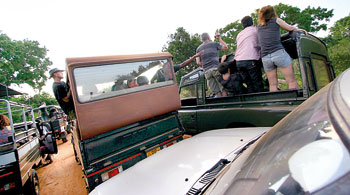Indiscipline among safari jeep drivers at the Yala National Park came to the fore, with an “accident” in which BBC Colombo correspondent Charles Haviland suffered a head injury last Tuesday.
This is not the first instance of speeding and accidents at Yala and will not be the last if the rules are not strictly enforced within this National Park, stressed an environmentalist citing the “road-kill” of even a leopard in recent times.
 |
| Traffic jam in Yala: Visitors in vehicles eagerly on the lookout to witness wildlife |
While environmentalists alleged that on holidays such as last Tuesday which was a poya nearly 300-400 vehicles enter Yala creating chaos and disturbing the wild animals, a source at the Department of Wildlife Conservation explained that the DWC was doing its best to curb the indiscipline and rein-in the safari jeep drivers.
The driver in whose jeep the foreigner suffered the injury has been banned from entering Yala for a few days, as he did not inform officials about the accident which happened within the park, the DWC source said, adding that the driver had taken the foreigner to the hospital and only informed the Tissamaharama Police about it.
“We do understand that the injured foreigner should be taken to hospital immediately but it is essential for the jeep driver to inform park officials even later,” the source pointed out.
Conflicting reports reached the Sunday Times about the “accident” where the foreigner had involuntarily shot up in his seat, when the vehicle sped over a hump, hitting his head on the bars running overhead. While DWC sources claimed that the accident took place close to the Sapaththu bokkuwa in Block 1 and environmentalists reported that the jeep had been speeding at over 100 km per hour after the driver was tipped off on his mobile that there was a leopard sighting, the Independent Safari Jeep Drivers’ Association was categorical that it happened just beyond the barrier at the entrance to Yala.
The association’s Secretary Tharindu Jayasinghe said the speed limit on the Yala main road is 40 km per hour. The road is being repaired by the Southern Provincial Council and due to excessive dust Yala officials had built a hump to slow down the vehicles but not put up signs warning drivers.
However, environmentalists claimed that the speed limit on all roads within the park should be 25 km per hour as people were in a park to see animals and were not going from place to place.
When the jeep in question went over the hump, the foreigner got thrown up, hitting his head on the hood pipes, Tharindu said, refuting allegations that the driver was speeding.
Tharindu whose association has a membership of 218, however, conceded that there were some issues with regard to vinaya (discipline) within Yala, but denied charges by environmentalists that whenever penalties are imposed on jeep drivers they sought political intervention to get off scot-free.
Claiming that friction among park officials was a matter of serious concern, he said that his association has instructed member-drivers to keep to the stipulated speed limit of 25 km per hour on athuru paraval (by-roads) coming under the DWC.
Referring to unruly acts such as speeding and sometimes even pelting stones into the jungle to get the wild animals out into the open which the association frowns upon, Tharindu said he has proposed that the Dialog tower should be switched off from 6 to 9 in the morning and 3 to 6 in the evening. Then not only jeep drivers but also trackers cannot inform each other from different vehicles that there has been an animal sighting which results in speeding as well as a huge jam taking place at that point, disturbing the animals.
Trackers also sometimes urge the drivers to go fast, he alleged.
Another DWC source, while explaining that two more entry points had been opened up at Katagamuwa and Galge in addition to Palatupana to ease the congestion, said that they had also repaired the roads and improved the waterholes in several areas so that animals would get distributed among them thus thinning out the visitor jam as well.
The source said that there was also a shortage of trackers and they were in the process of recruiting more. During holidays, as many as 400 vehicles enter the park and there are only about 50 trackers. As a result, usually safari jeep drivers are allowed in without trackers while the available trackers accompany visitor-driven vehicles.
As it is difficult to have a tracker for each safari jeep given the variation in the number of visitors on different days, an environmentalist suggested that it may be better for all visitors to be allowed in without trackers while the DWC has strong mobile patrols that strictly enforce the rules within the park.
Both DWC sources and Tharindu categorically denied that there was political interference whenever penalties were imposed on safari jeep drivers.
The overall verdict by environmentalists, however, was that there seemed to be no rules at Yala. What prevails is the law of the jungle in every sense, a frequent visitor to the National Park said, adding it’s a carnival in there, with the victims being the wild animals.
Pointing out that they had given up going to Yala because it was no longer a wilderness experience, many environmentalists warned that if this state of affairs continues tourists will also shy away from this National Park. |


